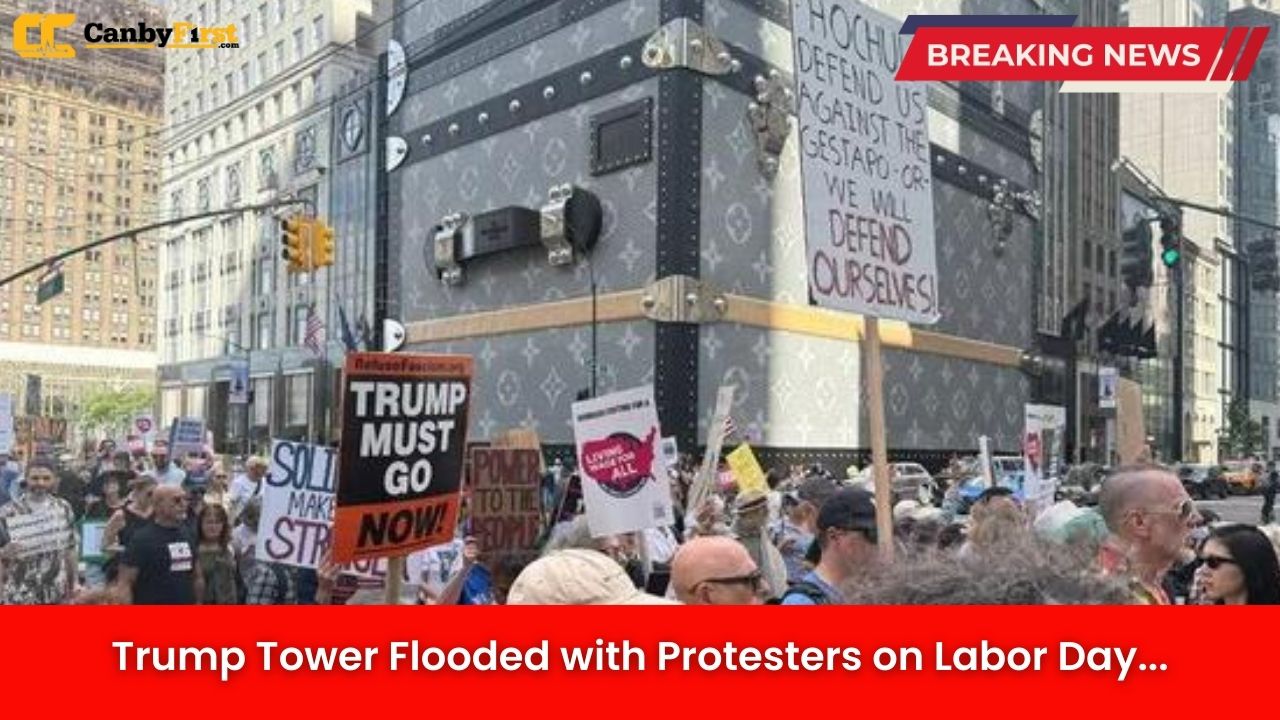New York, US: Thousands of demonstrators filled the streets surrounding Trump Tower on Monday in a massive Labor Day protest that echoed across Midtown Manhattan. Branded under the rallying cry “Workers Over Billionaires,” the gathering quickly swelled into one of the largest labor-oriented demonstrations in the city this year, disrupting traffic and drawing a heavy police presence.
The demonstration, organized by a coalition of labor unions, grassroots worker groups, and activist networks, began mid-morning but quickly grew into a sea of banners, chants, and marching crowds. Protesters accused former President Donald Trump and other wealthy elites of “hoarding wealth while working-class families struggle with soaring costs.”
A Show of Numbers and Anger
By midday, vast stretches of Fifth Avenue near Trump Tower were filled with people carrying handmade signs declaring, “Fair Wages, Not Tax Breaks” and “Workers Deserve Better.” Marching bands, megaphones, and coordinated chants created an atmosphere that was equal parts festival and fiery demonstration.
Also Read
“This is not just about one building or one man; it’s about a system that puts billionaires first and workers last,” said Carla Mendez, a subway conductor and union organizer who addressed the crowds from a makeshift stage. “On this Labor Day, we’re saying enough is enough.”
Law Enforcement Response
The New York Police Department maintained a strong presence, blocking access to portions of Fifth Avenue and setting up barricades to prevent demonstrators from entering Trump Tower itself. Although the protest was largely peaceful, brief tensions flared when a handful of participants attempted to push past barricades. Officers quickly intervened, but no major clashes were reported.
Police officials confirmed that multiple arrests were made for disorderly conduct after some protesters refused orders to clear intersections. Despite the disruptions, the demonstration remained largely nonviolent.
Political Symbolism of the Location
Choosing Trump Tower as the epicenter of the protest was deliberate, organizers said. The Manhattan skyscraper, once the personal residence and campaign hub of Trump, has long stood as a symbol of wealth and political power. On Labor Day, activists transformed it into a gathering place to confront what they described as decades of “policies favoring corporations, tax breaks for the wealthy, and stagnant wages for workers.”
“Trump Tower represents billionaire culture at its peak,” said David Cho, a labor rights attorney at the event. “By standing here, workers are sending a message that policies written in gilded halls cannot continue to dictate the lives of struggling families.”
Voices from the Crowd
Many participants were first-time demonstrators, while others said they had been protesting for years. Teachers, nurses, janitors, delivery drivers, and construction workers all marched side by side. At several moments, union leaders led chants demanding stronger protections for essential workers and calling for a higher federal minimum wage.
“This isn’t partisan—this is survival,” said Angela Ruiz, a hospital nurse who marched with a coalition of healthcare workers. “We’ve worked on the frontlines for years, through crises and shortages, and still we can’t afford rent while billionaires buy yachts. We’re done staying silent.”
Broader Labor Discontent
The Labor Day march comes amid a broader wave of worker unrest across the country. From strikes among auto workers in the Midwest to nationwide pushes for higher wages in service industries, the movement for economic justice has gained renewed momentum in the past two years. Rising inflation, combined with stagnant wage growth and mounting living costs, has fueled frustration among working-class Americans.
“Labor Day was meant to honor workers, but today it feels like a reminder of how undervalued we are,” said John Peterson, a striking delivery driver from Queens. “This is about making sure the next generation doesn’t face worse conditions than we do now.”
The Bigger Question: What Next?
City officials acknowledged the magnitude of the demonstration but stressed the importance of peaceful advocacy. Mayor’s office representatives said they respected the right to protest but urged demonstrators to avoid property damage and ensure safety.
While the Trump Tower protest concluded in the evening with speeches, music, and a symbolic “workers’ march” circling the skyscraper, organizers promised this was only the beginning.
“We are tired of billionaires being lionized while the rest of us are crushed under debt, bills, and 12-hour shifts,” declared one final speaker, closing out the gathering. “Labor Day should be the workers’ holiday—and today we made sure it was.”
As the crowds dispersed, the echoes of their chants lingered across Midtown: a reminder of escalating labor tensions and the growing determination of workers nationwide to demand what they believe is long overdue—fair pay, fair treatment, and a future not built on billionaires’ terms.












